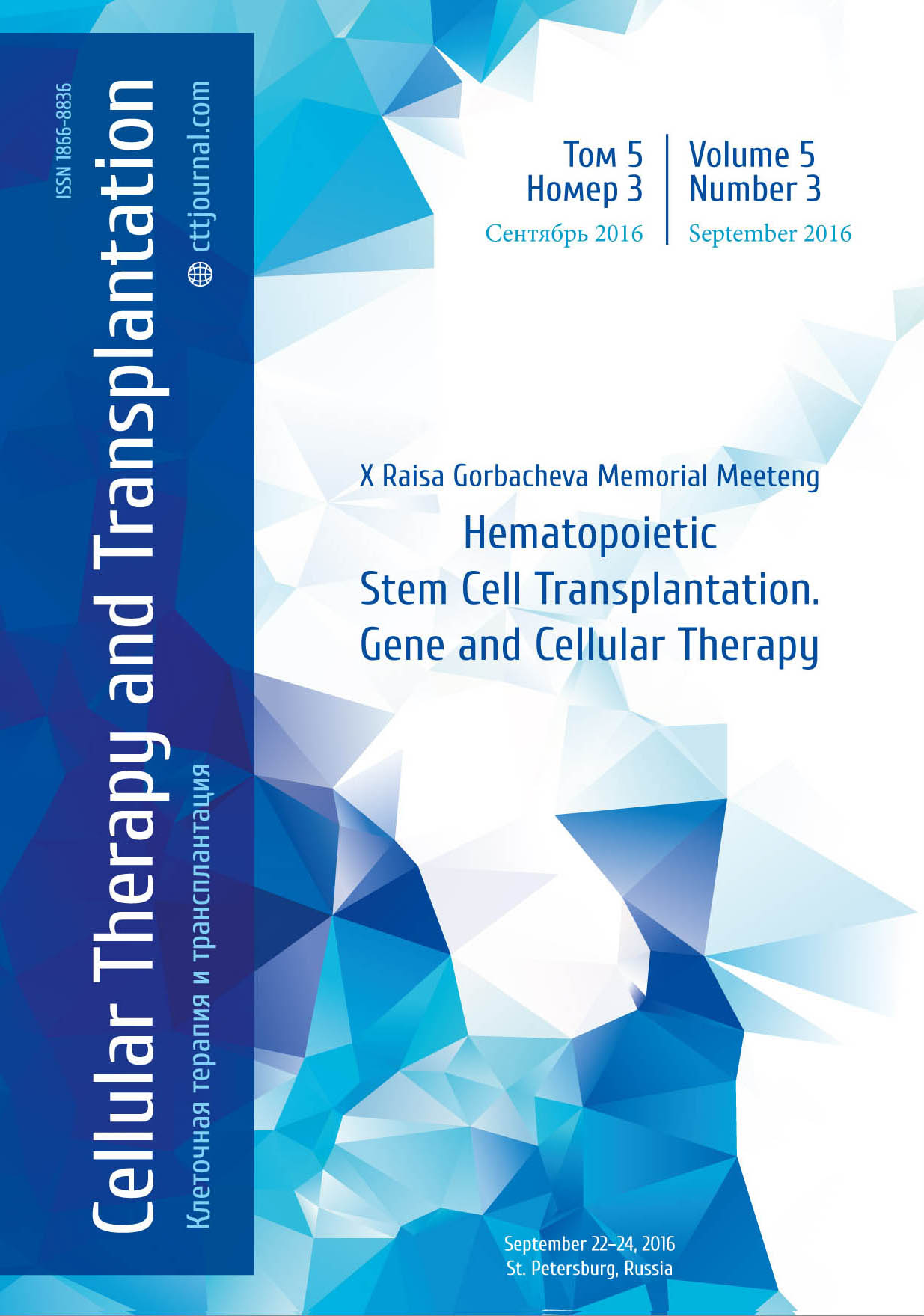Risk-adapted graft-versus-host disease prophylaxis with post-transplantation cyclophosphamide in related, unrelated and haploidentical stem cell transplantations
Accepted 29 September 2016
Summary
Introduction
There is a growing evidence of safety and efficacy of post-transplantation cyclophosphamide (PTCy) in related and haploidentical bone marrow (BM) transplantations, but the data regarding unrelated and peripheral blood stem cell (PBSC) transplants is limited. Hence, we conducted a prospective trial of risk-adapted graft-versus-host disease (GVHD) prophylaxis with PTCy that included different types of donors and graft sources.
Patients and methods
200 adult patients (median age 32 y.o., range 18-62) with hematologic malignancies, including AML (47.5%), ALL (26.5%), CML (12%), MDS (4%), and lymphomas (10%), were enrolled into NCT02294552 trial. 23% of patients were classified as salvage. 26% received the graft from matched related (MRD), 65% from matched/mismatched unrelated (MUD/MMUD), and 9% from haploidentical (haplo) donor. 43% received BM graft and 57%- PBSC graft. 18.5% had myeloablative conditioning and 81.5% - reduced-intensity conditioning. GVHD prophylaxis for matched BM graft consisted of single-agent PTCy 50 mg/kg days+3,+4; for matched PBSC graft we used PTCy+ tacrolimus+ mycophenolate mofetil (MMF) 30 mg/kg days 5-35, and for any mismatched graft, PTCy+ tacrolimus+ MMF 45 mg/kg at days 5-35. Median follow-up was 17 months (range 3-38).
Results
Grade II-IV, III-IV acute GVHD, and moderate-severe chronic GVHD in MRD, MUD/MMUD and haplo groups were respectively 8% (95% CI 3-21%) vs 18% (95% CI 13-26%) vs 26% (95% CI 11-61%), p=0.16; 4% (95% CI 1-16%) vs 6% (95% CI 3-12%) vs 0%, p=0.57; 15% (95% CI 7-29%) vs 10% (95% CI 5-17%) vs 16% (95% CI 5-59%), p=0.35. Non-relapse mortality (NRM) and relapse incidence were 8% (95% CI 3-22%) vs 14% (95% CI 9-21%) vs 16% (95% CI 6-45%), p=0.50, and 38% (95% CI 3066%) vs 23% (95% CI 16-32%) vs 45% (95% CI 27-76%), p=0.02 for MRD, MUD/MMUD and haplo group, respectively. 2-year overall survival (OS), event-free-survival (EFS), and GVHD-relapse free survival (GFRS) were 70% (95% CI 53-82%) vs 67% (95% CI 57-75%) vs 44% (95% CI 21-65%), p=0.007; 53% (95% CI 38-67%) vs 64% (95% CI 54-72%) vs 36% (95% CI 15-57%), p=0.009; 37% (95% CI 23-51%) vs 59% (95% CI 50-67%) vs 36% (95% CI 15-57%), p=0.035 for MRD, MUD/MMUD and haplo groups, respectively. There were no statistical differences in OS, EFS and GFRS between MUD and MMUD (p>0.05). In a multivariate analysis, only salvage status (HR 3.0 95%CI 1.94.7, p < 0.0001) and occurrence of sepsis (HR 1.7 95%CI 1.0-2.7, p=0.04) were predictive for EFS, while type of donor was not a significant factor (HR 1.1 95%CI 0.7-1.9, p=0.60) (Fig. 1). The incidences of complications were: hemorrhagic cystitis, 23%; sepsis, 24%; severe sepsis, 8%; invasive mycosis, 8%; CMV reactivation 45%; veno-occlusive disease, 2.5%; transplant-associated microangiopathy, 3.5%; grade 3/4 liver toxicity, 14%; grade 3/4 kidney toxicity, 1%. Conclusion With relatively short follow-up, we have demonstrated that the risk-adapted PTCy GVHD prophylaxis is safe and results in very low incidences of NRM, acute and chronic GVHD. Therefore, it could be used with any kind of graft source. It also alleviates the GVHD risk in MMUD and haplo donor settings. Relapse of underlying malignancy still significantly influences the outcome with this mode of prophylaxis.
Keywords
Allogeneic hematopoietic cell transplantation, cyclophosphamide, graftversus-host disease (gvhd), prophylaxis
Accepted 29 September 2016


